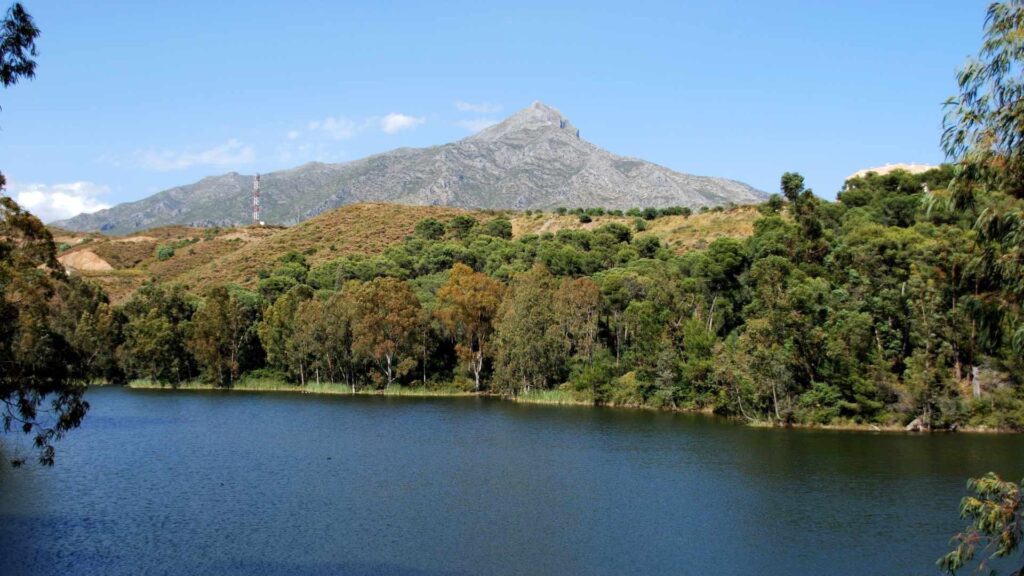Updated: 28 September 2025
The Nueva Andalucia Climate is one of the strongest lifestyle drivers in Marbella’s district of Nueva Andalucia. Nestled inland from Puerto Banús, this green residential enclave enjoys a sheltered microclimate created by the Sierra Blanca mountains and the Mediterranean Sea. The result is a weather pattern that combines hot, dry summers, mild winters, and nearly 3,000 hours of sunshine per year—a true paradise for those seeking year-round outdoor living. This overview reflects exactly what the climate is like in Nueva Andalucia throughout the year.
But what does that look like month by month, and how does it affect property values and lifestyle choices? Let’s dive deeper.
How warm is Nueva Andalucia in summer?
Summers in Nueva Andalucia are defined by long, dry, sun-drenched days—one of the most defining aspects of the Nueva Andalucia Climate.
-
Average highs: 28–32°C (82–90°F).
-
Peak months: July and August, with minimal rainfall.
-
Sunlight: Up to 12 hours of sunshine daily.
Despite the heat, Nueva Andalucia is spared from the extremes of inland Spain thanks to cooling Mediterranean breezes. Humidity is lower than in Marbella Town, making evenings more comfortable.
“Nueva Andalucia enjoys up to 12 hours of sunshine daily during peak summer.”
For residents, this season means poolside relaxation, golf in the early mornings, and evening dining outdoors. It’s also peak tourist season, which fuels rental demand. Villas with pools and shaded terraces are particularly sought-after during these months, especially by those evaluating investment opportunities in Nueva Andalucia property.
How mild are winters in Nueva Andalucia?
One of the biggest draws for international residents is the gentle winter climate.
-
Daytime highs: 15–18°C (59–64°F).
-
Coolest month: January, averaging 12–14°C.
-
Frost or snow: Virtually unknown.
While Northern Europe shivers, the Nueva Andalucia Climate delivers winters that feel like spring in most of Europe. Golfers enjoy playable courses year-round, and cafes spill onto terraces even in December.
“Winters here feel more like early spring in most of Europe.”
This mild climate is a key reason Marbella has become a second-home hotspot for Scandinavian, German, and British buyers, many of whom compare the lifestyle benefits of the two areas when deciding whether living in Nueva Andalucia is better than Marbella.
How much rainfall does Nueva Andalucia receive annually?
Rainfall is moderate, creating a green landscape without tropical humidity.
-
Annual average: 500–600 mm.
-
Rainiest months: November to February.
-
Driest months: June to August.
| Location | Average Annual Rainfall | Wettest Months | Driest Months |
|---|---|---|---|
| Nueva Andalucia | 500–600mm | Nov–Feb | Jun–Aug |
| Marbella Town | 600–650mm | Nov–Feb | Jun–Aug |
| Estepona | 650–700mm | Nov–Mar | Jun–Aug |
Because of its valley location, Nueva Andalucia is slightly drier than Estepona. Rain typically arrives in short, heavy bursts followed by sunshine—rarely do entire days get washed out. This can matter for buyers researching how the Nueva Andalucia real estate market is performing right now.
What is spring like in Nueva Andalucia?
Spring is widely considered the sweet spot of the year.
-
Temperatures: 18–24°C (64–75°F).
-
Rain: Declines rapidly after March.
-
Lifestyle: Ideal for golf, hiking, and terrace dining.
By April, sunny days dominate, and May often feels like early summer. Locals and visitors alike enjoy warm days without the crowds of July and August.
“By May, sea temperatures rise enough for early beach swimming.”
Spring is also one of the busiest periods for property viewings, particularly among buyers examining the best areas to live in Nueva Andalucia.
How long does autumn last in Nueva Andalucia?
Autumn in Nueva Andalucia stretches from late September to early November.
-
Temperatures: 20–27°C (68–81°F).
-
Rain: Increases slightly in November.
-
Vibe: Summer atmosphere lingers, but with fewer crowds.
October, in particular, is a favorite month for second-home owners. It still feels like summer in Northern Europe, but without high-season congestion. Many describe it as a “second spring.”
“October feels like summer in many other European countries.”
This period is also known as a mini high season for real estate, attracting both lifestyle buyers and those exploring real estate investment opportunities in southern Spain.
How many sunshine hours does Nueva Andalucia get yearly?
One of Nueva Andalucia’s greatest assets is its abundant sunshine.
-
Annual sunshine: 2,900–3,000 hours.
-
European average: 1,600–2,000 hours.
| Region | Annual Sunshine Hours |
|---|---|
| Nueva Andalucia | 2,900–3,000 |
| Marbella | 2,850–2,950 |
| Estepona | 2,800–2,900 |
| London, UK | ~1,500 |
| Stockholm, Sweden | ~1,800 |
This makes the area particularly attractive for remote workers, retirees, and wellness seekers who prioritize year-round outdoor living, especially those comparing the cost of living in Nueva Andalucia before relocating.
How does the microclimate differ from Marbella Town?
Nueva Andalucia benefits from a unique valley microclimate.
-
Summers: Slightly cooler than Marbella Town, thanks to mountain breezes.
-
Winters: Slightly warmer and less damp.
-
Protection: Sierra Blanca mountains shield against storms and winds.
“Sheltering mountains reduce winds and stabilize year-round temperatures.”
This consistent Nueva Andalucia Climate is a major selling point for property buyers, especially those also researching the best areas to buy property in Marbella.
How does the climate affect real estate in Nueva Andalucia?
The weather directly influences property demand and values.
-
Homes with pools, south-facing terraces, and outdoor kitchens are in high demand.
-
Properties with mountain or sea views command premiums.
-
Golf-front villas benefit from year-round playability.
According to Quintessentia Property Advisors, climate-related features such as heated pools, shaded pergolas, and energy-efficient cooling systems are key to marketability.
“Climate is not just lifestyle here—it is property value.”
For investors, this means a strong rental market: short-term demand peaks in summer, while long-term rentals thrive thanks to retirees and expats—many of whom analyse rental yields for properties in Nueva Andalucia before buying.
How does Nueva Andalucia compare to Estepona for climate?
While both towns share Costa del Sol’s sunny reputation, differences exist.
| Factor | Nueva Andalucia | Estepona |
|---|---|---|
| Average Winter Highs | 15–18°C | 14–16°C |
| Annual Rainfall | 500–600mm | 650–700mm |
| Sunshine Hours | 2,900–3,000 | 2,800–2,900 |
| Sea Breeze Influence | Moderate Mediterranean | Stronger Atlantic breezes |
Estepona, positioned further west, receives more rainfall and occasional Atlantic winds, while the Nueva Andalucia climate enjoys slightly warmer, drier winters thanks to its sheltered valley. These factors also influence buyers choosing between Nueva Andalucia and the best areas to live in Estepona.
Does the sea temperature allow swimming year-round?
Sea temperatures vary seasonally:
-
Winter: 15–16°C, cool but swimmable for hardy residents.
-
Spring/Autumn: 18–21°C, pleasant for most.
-
Summer: 22–24°C, ideal for families and casual swimmers.
“Summer sea temperatures average 23°C, ideal for family beach days.”
Many locals swim year-round, though July to September is peak beach season. Warmer waters compared to northern Spain make Nueva Andalucia especially appealing for beach lovers, particularly those also browsing beachfront apartments for sale in Marbella.
Frequently Asked Questions about Nueva Andalucia Climate
Is air conditioning necessary?
Yes, particularly in July and August. However, Mediterranean breezes and cooler nights reduce overall energy use.
How humid is Nueva Andalucia compared to Marbella?
Average humidity is 65–70%, slightly lower than Marbella Town, thanks to valley breezes.
Can you golf year-round?
Yes. Winter highs of 16–18°C mean courses rarely close, making Nueva Andalucia a global golf destination—ideal for those exploring the best golf courses located in Nueva Andalucia.
Does the area experience extreme weather?
No. Storms are rare, and the Sierra Blanca mountains provide natural protection.
What is the best time to visit?
April–June and September–October are considered the most comfortable months, though the Nueva Andalucia climate makes year-round living attractive.
Lifestyle Impact: Why Climate Matters for Residents and Buyers
The predictable sunshine in Nueva Andalucia shapes everyday life. Residents enjoy:
-
Outdoor dining for most of the year.
-
Al fresco fitness—yoga, tennis, golf, and hiking.
-
Year-round tourism, fueling rental income.
-
Lower heating bills compared to Northern Europe.
For buyers, this means investing not only in a property but also in a climate-driven lifestyle. Villas designed with outdoor kitchens, infinity pools, and shaded terraces offer more than comfort—they offer resale value and rental appeal. Many prospective buyers also check the steps involved in purchasing real estate in Spain as part of their planning.
Conclusion
The Nueva Andalucia’s climate is more than just a pleasant backdrop, it’s a pillar of its desirability. With hot but breezy summers, mild winters, and almost 3,000 hours of sunshine annually, it delivers one of Europe’s most reliable year-round environments.
The Sierra Blanca’s microclimate effect ensures stable, predictable conditions that enhance both lifestyle and property investment. For families, retirees, and investors, the climate translates into comfort, value, and opportunity.
From spring golf days to autumn beach swims, Nueva Andalucia proves why its weather is one of the strongest selling points of the Marbella region.


